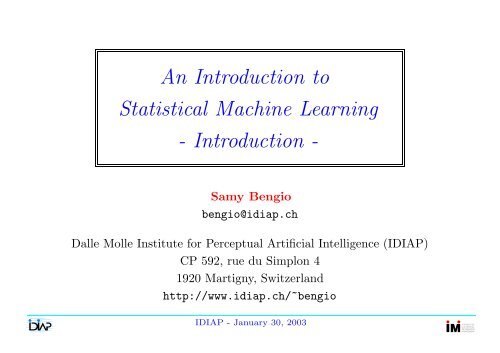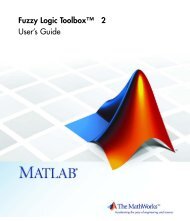An Introduction to Statistical Machine Learning ... - Samy Bengio
An Introduction to Statistical Machine Learning ... - Samy Bengio
An Introduction to Statistical Machine Learning ... - Samy Bengio
Create successful ePaper yourself
Turn your PDF publications into a flip-book with our unique Google optimized e-Paper software.
<strong>An</strong> <strong>Introduction</strong> <strong>to</strong><br />
<strong>Statistical</strong> <strong>Machine</strong> <strong>Learning</strong><br />
- <strong>Introduction</strong> -<br />
<strong>Samy</strong> <strong>Bengio</strong><br />
bengio@idiap.ch<br />
Dalle Molle Institute for Perceptual Artificial Intelligence (IDIAP)<br />
CP 592, rue du Simplon 4<br />
1920 Martigny, Switzerland<br />
http://www.idiap.ch/~bengio<br />
IDIAP - January 30, 2003
<strong>Introduction</strong> <strong>to</strong> <strong>Machine</strong> <strong>Learning</strong><br />
1. What is <strong>Machine</strong> <strong>Learning</strong><br />
2. Why is it difficult<br />
3. Basic Principles<br />
(a) Occam’s Razor<br />
(b) <strong>Learning</strong> as a Search Problem<br />
4. Types of Problems<br />
(a) Regression<br />
(b) Classification<br />
(c) Density Estimation<br />
5. Applications<br />
6. Documentation<br />
<strong>Introduction</strong> <strong>to</strong> <strong>Machine</strong> <strong>Learning</strong> 2
What is <strong>Machine</strong> <strong>Learning</strong> (Graphical View)<br />
<strong>Introduction</strong> <strong>to</strong> <strong>Machine</strong> <strong>Learning</strong> 3
What is <strong>Machine</strong> <strong>Learning</strong><br />
• <strong>Learning</strong> is an essential human property<br />
• <strong>Learning</strong> means changing in order <strong>to</strong> be better (according <strong>to</strong> a<br />
given criterion) when a similar situation arrives<br />
• <strong>Learning</strong> IS NOT learning by heart<br />
• <strong>An</strong>y computer can learn by heart, the difficulty is <strong>to</strong> generalize a<br />
behavior <strong>to</strong> a novel situation<br />
<strong>Introduction</strong> <strong>to</strong> <strong>Machine</strong> <strong>Learning</strong> 4
Why <strong>Learning</strong> is Difficult<br />
• Given a finite amount of training data, you have <strong>to</strong> derive a<br />
relation for an infinite domain<br />
• In fact, there is an infinite number of such relations<br />
• How should we draw the relation<br />
<strong>Introduction</strong> <strong>to</strong> <strong>Machine</strong> <strong>Learning</strong> 5
Why <strong>Learning</strong> is Difficult (2)<br />
• Given a finite amount of training data, you have <strong>to</strong> derive a<br />
relation for an infinite domain<br />
• In fact, there is an infinite number of such relations<br />
• Which relation is the most appropriate<br />
<strong>Introduction</strong> <strong>to</strong> <strong>Machine</strong> <strong>Learning</strong> 6
Why <strong>Learning</strong> is Difficult (3)<br />
• Given a finite amount of training data, you have <strong>to</strong> derive a<br />
relation for an infinite domain<br />
• In fact, there is an infinite number of such relations<br />
• ... the hidden test points...<br />
<strong>Introduction</strong> <strong>to</strong> <strong>Machine</strong> <strong>Learning</strong> 7
Occam’s Razor’s Principle<br />
• William of Occam: Monk living in the 14th century<br />
• Principle of Parcimony:<br />
One should not increase, beyond what is necessary, the<br />
number of entities required <strong>to</strong> explain anything<br />
• When many solutions are available for a given problem, we<br />
should select the simplest one<br />
• But what do we mean by simple<br />
• We will use prior knowledge of the problem <strong>to</strong> solve <strong>to</strong> define<br />
what is a simple solution<br />
Example of a prior: smoothness<br />
<strong>Introduction</strong> <strong>to</strong> <strong>Machine</strong> <strong>Learning</strong> 8
<strong>Learning</strong> as a Search Problem<br />
Initial solution<br />
Set of solutions chosen a priori<br />
Optimal solution<br />
Set of solutions<br />
compatible with training set<br />
<strong>Introduction</strong> <strong>to</strong> <strong>Machine</strong> <strong>Learning</strong> 9
Types of Problem<br />
• There are 3 kinds of problems:<br />
◦ regression<br />
<strong>Introduction</strong> <strong>to</strong> <strong>Machine</strong> <strong>Learning</strong> 10
Types of Problem<br />
• There are 3 kinds of problems:<br />
◦ regression, classification<br />
<strong>Introduction</strong> <strong>to</strong> <strong>Machine</strong> <strong>Learning</strong> 11
Types of Problem<br />
• There are 3 kinds of problems:<br />
◦ regression, classification, density estimation<br />
P(X)<br />
X<br />
<strong>Introduction</strong> <strong>to</strong> <strong>Machine</strong> <strong>Learning</strong> 12
• Vision Processing<br />
◦ Face detection/verification<br />
◦ Handwritten recognition<br />
• Speech Processing<br />
Applications<br />
◦ Phoneme/Word/Sentence/Person recognition<br />
• Others<br />
◦ Finance: asset prediction, portfolio and risk management<br />
◦ Telecom: traffic prediction<br />
◦ Data mining: make use of huge datasets kept by large<br />
corporations<br />
◦ Games: Backgammon, go<br />
◦ Control: robots<br />
• ... and plenty of others of course!<br />
<strong>Introduction</strong> <strong>to</strong> <strong>Machine</strong> <strong>Learning</strong> 13
Documentation<br />
• <strong>Machine</strong> learning library: www.Torch.ch<br />
• Journals:<br />
◦ Journal of <strong>Machine</strong> <strong>Learning</strong> Research<br />
◦ Neural Computation<br />
◦ IEEE Transactions on Neural Networks<br />
• Conferences:<br />
◦ NIPS: Neural Information Processing Systems<br />
◦ COLT: Computational <strong>Learning</strong> Theory<br />
◦ ICML: International Conference on <strong>Machine</strong> <strong>Learning</strong><br />
◦ ICANN & ESANN: 2 European conferences<br />
• Books:<br />
◦ Bishop, C. Neural Networks for Pattern Recognition, 1995.<br />
◦ Vapnik, V. The Nature of <strong>Statistical</strong> <strong>Learning</strong> Theory, 1995.<br />
<strong>Introduction</strong> <strong>to</strong> <strong>Machine</strong> <strong>Learning</strong> 14
Documentation<br />
• Search engines:<br />
◦ NIPS online: http://nips.djvuzone.org<br />
◦ NEC: http://citeseer.nj.nec.com/cs<br />
• Other lecture notes: (some are in french...)<br />
◦ <strong>Bengio</strong>, Y.: http://www.iro.umontreal.ca/˜bengioy/ift6266/<br />
◦ Kegl, B.: http://www.iro.umontreal.ca/˜kegl/ift6266/<br />
◦ Jordan, M.:<br />
http://www.cs.berkeley.edu/˜jordan/courses/294-fall98/<br />
<strong>Introduction</strong> <strong>to</strong> <strong>Machine</strong> <strong>Learning</strong> 15







